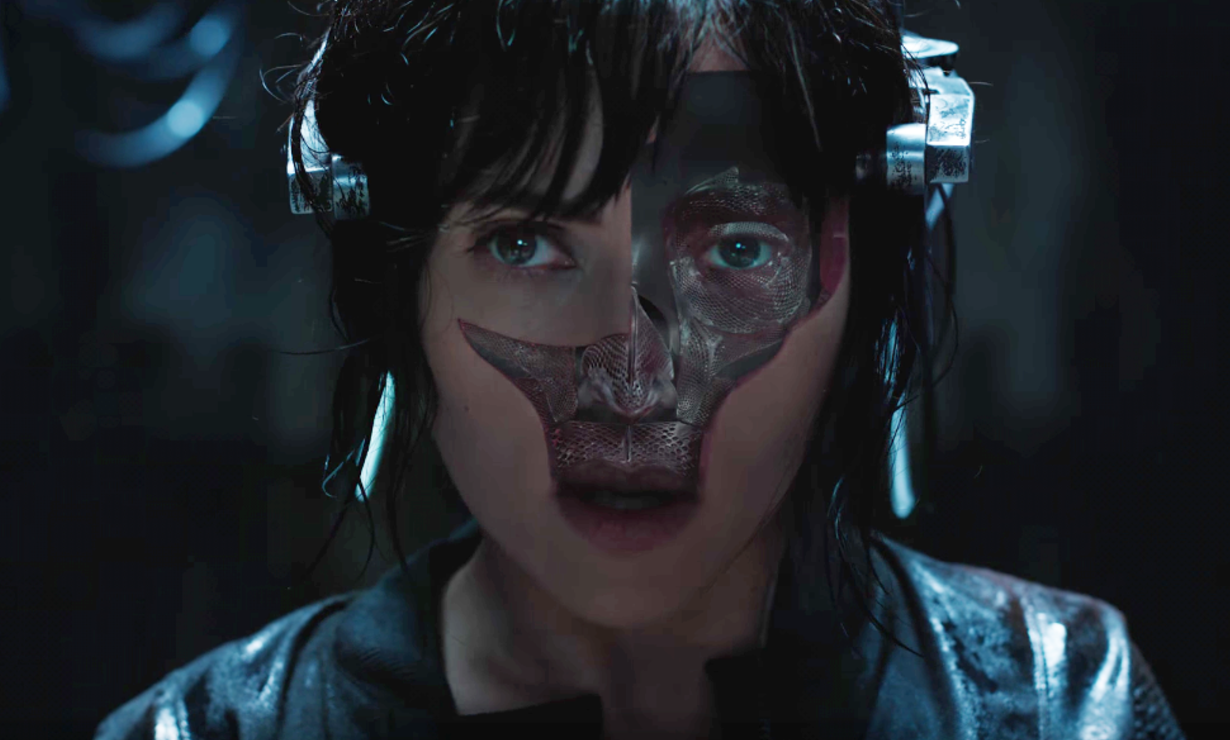“We cling to our memories as though they define us. But it’s our actions that define us.” So regurgitates Mira Killian a.k.a. Motoko Kusanagi (Scarlett Johansson, the perfect femmebot casting) as she does her best to convince herself that there’s nothing wrong with being a cyborg. Rupert Sanders’ sophomore film (his first was also the big budget Snow White and the Huntsman back in 2012) was not an easy one to take on, primarily for the backlash against Johansson’s casting and the immense and devoted following Ghost in the Shell in both its manga and original film form possesses. Still, screenwriters Jamie Moss, William Wheeler and Ehren Kruger do their best to combine all the best and pertinent elements of the original, leaving intact the inherent message of Ghost in the Shell (even if it’s a bit more reined in): the more pervasive technology becomes in our everyday lives–within our literal existence–the harder it becomes to differentiate what it means to be human versus machine.
Intended to take place in 2029, with a backstory described at the intro to the original film as, “In the not so distant future, when the corporate networks fill the earth with electronic and optical communication lines, but society has not yet been too computerized to erase nations and races…,” Ghost in the Shell bequeaths us with an all too possible glimpse into the crystal ball of the future. For Mira, however, the existence within her shell feels all too ordinary until she begins having memories that aren’t truly her own. Bringing out the frustration of her inability to truly remember her past, Mira begins delving into areas and ghosts that the anti-terrorist bureau she works for, Section 9, doesn’t want her to explore without their input. Her rogue actions lead the CEO of Hanka Robotics, Cutter (Peter Ferdinando), to threaten Mira’s “creator,” Dr. Ouelet (Juliette Binoche), to abort the entire operation until they can manufacture a less human model.
This emphasis on the notion that to be human is a machine’s greatest weakness comprises the core philosophy of Ghost in the Shell, posing the question: “What exactly is the definition of ‘human’ in a society where a mind can be copied and the body replaced with a synthetic form?” There is no clear-cut answer, as Section 9’s cyborgs show time and time again–particularly with regard to matters of the (metaphorical) heart. As is the case when Mira encounters Kuze (marking the return of Michael Pitt in a mainstream role), a ghost capable of hacking into just about any shell.
The threat he poses to Section 9 is more than just his ability to destroy everything he touches, but also his connection to Mira, who he instructs to question Dr. Ouelet about her past, and just how many times they had to experiment after Kuze, alias Project 2571 (in the original, it’s Project 2501–a blonde woman instead of Michael Pitt–that proves taboo).
With the anime film directed by Mamoru Oshii, there was more politicized gumption to its much tauter one hour and twenty-two minute runtime. The ironic contrast of a man saying, “I don’t believe it. Our country is a peace-loving democracy,” followed by the windows shattering from the impact of gunshots drive home the point that there is no democracy, only technology spurred by counter-intelligence. And “thermoptic camouflage” is just one of the many ways in which our ghost in the shell can infiltrate, a special effect played up to a lesser extent in the live action version.
And yet, as Motoko in the original points out, “Overspecialize and you breed in weakness. It’s slow death.” Perhaps this is why the remake of Ghost in the Shell sifts its plot from as many of the storylines as possible, which may or may not appeal to its original creator, Masamune Shirow (probably not). In its latest incarnation, the most faithful character reimagining of all is the goggle-eyed Batou (Pilou Asbæk), still surly and devoted to Mira as ever. Granted, his gruffness with regard to humans in the 1995 version is more palpable as he notes, “Ghost half humans are so pathetic it’s such a shame.”
Mira’s insistence about actions instead of memories defining us also reveals itself to be more intense when the Motoko of 1995 is told after watching a man realizing that his memories were part of simulated experience, “Any information a human accumulates in a lifetime is just a drop in the bucket.”
The Motoko of 1995, Daria-like in her stoicism as she may be, still seems to feel more deeply the loss of her humanity for a time, coming to terms with the fact that, “Cyborgs like myself have a tendency to be paranoid about our origins. Sometimes I suspect I’m not who I think I am. Like maybe I died a long time ago and someone took my brain and stuck it in this body. Maybe there never was a real me in the first place and I’m completely synthetic like that thing.”
Even as humans, many of us can feel this way, particularly as the concept of morality becomes more nebulous to the masses (e.g. 2016 election), in large part due to the prevalence of technology and the desensitization it causes in our day-to-day lives. In 1995’s Ghost in the Shell, blonde female cyborg form Kuze warns, “If memory cannot be defined, but it defines mankind, the advent of computers and the subsequent accumulation of incalculable data has given rise to a new system of memory and thought parallel to your own. Humanity has underestimated the consequences of computerization.”
In short, the manipulation of memory in the computer age is tantamount to the devil citing scripture for his own purpose, which, love or hate Sanders’ and Johansson’s reinterpretation of Ghost in the Shell, the film still gets across.





















